

The Life and Work of Robert Alexander Gilbert: Empowering New Insights through Digitization and Transcription of Archival Materials. This post is part of a series from the Ernst Mayr Library exploring the digitization and transcription of ornithologist William Brewster’s archival materials and the insights and scholarship made possible thanks to this work.
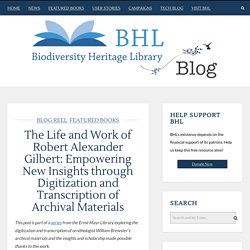
Robert A. Gilbert, far right, at William Brewster’s cabin at Pine Point, Umbagog Lake, Maine. From the collection of the Museum of American Bird Art, Massachusetts Audubon Society and reproduced with their permission. Robert Alexander Gilbert (1870-1942) was a Black photographer interested in ornithology and chemistry who worked for ornithologist William Brewster from the mid 1890s until Brewster’s death in 1919 and at various tasks around the Museum of Comparative Zoology (MCZ) at Harvard University beyond 1919. He was an Associate of the American Ornithologists’ Union. Gilbert was not officially recognized for his photographic work with William Brewster, although Brewster did not claim credit for all the images in his collection.
Journal, June 8, 1897. Updates to Bibliography Pages in BHL. We have updated the bibliography pages in BHL to streamline the presentation of information about and metadata export options for content in the Library.

Previously, bibliographic details and export options were available through different tabs on title and part pages. These tabs have now been removed, and all bibliographic information is consolidated into a single display. The various tabs on title and part bibliography pages have now been consolidated into a single display. BHL’s metadata export options have also been relocated. BHL offers metadata exports in MODS, BibTex, and RIS formats. Teaching Rare Book Cataloguing During a Pandemic. As I am writing this, Melbourne is at the end of its second wave of COVID-19 and I have been separated from the library collections that I work with at Museums Victoria for six months, 25 days, 21 hours, and around 12 minutes… but who’s counting?!
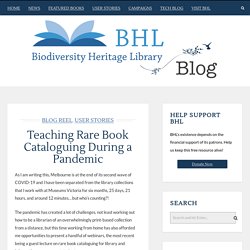
The pandemic has created a lot of challenges, not least working out how to be a librarian of an overwhelmingly print-based collection from a distance, but this time working from home has also afforded me opportunities to present a handful of webinars, the most recent being a guest lecture on rare book cataloguing for library and information management students. I can say without a doubt that this would have been a near impossible task without the Biodiversity Heritage Library. The two-page view on BHL allowed me to flick through books virtually in the same manner as a physical object in order to indicate some of the things we might look for when cataloguing rare books. Plate and text page 299. Collins, David.
Why is access to biodiversity knowledge so important? GGL: This is a bit more technical, but I’m fascinated with the Nagoya Protocol, and the question of Access and Benefit Sharing–another contentious space.
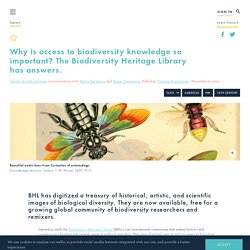
I study the UN Food and Agriculture Organization’s International Treaty of Plant Genetic Resources for Food and Agriculture, where I see this argument unfold. There’s a vision of Open Knowledge: just circulate the data about all of the resources that are kept ex situ. And then there’s movements saying, “well, we still need to have prior informed consent, to prevent appropriation.” Time Traveling with BHL: Open Access to Historic Data Empowers Modern Research…At Home. As the world’s largest open access digital library for biodiversity literature and archives, the Biodiversity Heritage Library (BHL) has revolutionized global research by providing free, worldwide access to knowledge about life on Earth.
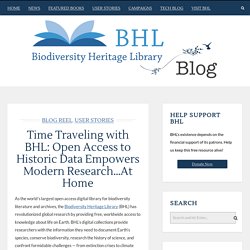
BHL’s digital collections provide researchers with the information they need to document Earth’s species, conserve biodiversity, research the history of science, and confront formidable challenges — from extinction crises to climate change and the spread of zoonotic diseases. Digital access to this essential literature is especially important right now, as the COVID-19 pandemic makes physical access to collections and institutional libraries impossible for many. Open access digital libraries like BHL make continued research possible. Dr. Exploring the People and Stories Behind the Names: BHL Empowers Research on Taxonomic History.
In 1780, French naturalist François Le Vaillant traveled to the Cape of Good Hope and subsequently spent several years studying the region’s biodiversity.
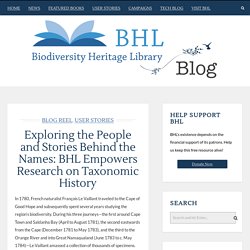
During his three journeys—the first around Cape Town and Saldanha Bay (April to August 1781), the second eastwards from the Cape (December 1781 to May 1783), and the third to the Orange River and into Great Namaqualand (June 1783 to c. May 1784)—Le Vaillant amassed a collection of thousands of specimens. Upon returning to Europe, he published accounts of his travels within Voyage dans l’intérieur de l’Afrique (1790, 2 vols.) and Second voyage dans l’intérieur de l’Afrique (1796, 3 vols.) —both of which were best sellers and were translated into several languages.
Within these narratives, Le Vaillant writes repeatedly of his Khoikhoi guide, whom he called Klaas (but whose name in Klaas’s own Khoe language seems to be unrecorded). Klaas’s cuckoo (Chrysococcyx klaas). Towards Online Decoloniality: Globality and Locality in and Through the BHL. This post is written by Lidia Ponce de la Vega, a Ph.D.
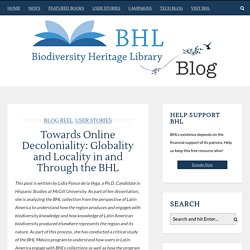
Candidate in Hispanic Studies at McGill University. Meadowfoam and Cluster-Lilies: Empowering Research on Rare Plants Through Open Access to Biodiversity Literature. BHL Quarterly Newsletter (August 2020) Now Available! The world has changed dramatically over the past few months.
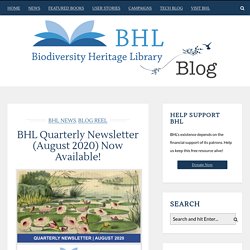
These changes have profoundly impacted our personal and professional lives and altered the way we do our jobs, access information, share ideas, interact with friends and colleagues, and think about the future. As we face these unprecedented challenges together, we at BHL are committed to ensuring continued, free access to information and resources that empower research, education, creativity and discovery for everyone—no matter where you are. In our latest newsletter, we share some of the ways we have been working to improve the Library over the past few months, such as deploying a new taxonomic name finding tool and making our records available in WorldCat. Additionally, with many of our partners now operating in a telework environment, we have focused on projects to improve our digital collections remotely, such as uploading born digital content, improving collection metadata, and building our image collections on Flickr.
BHL Improves the Speed and Accuracy of its Taxonomic Name Finding Services with gnfinder. BHL has deployed a new taxonomic name finding tool to improve the speed and accuracy of identifying names throughout its 58+ million pages.
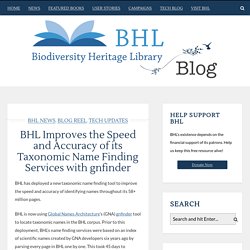
BHL is now using Global Names Architecture’s (GNA) gnfinder tool to locate taxonomic names in the BHL corpus. Prior to this deployment, BHL’s name finding services were based on an index of scientific names created by GNA developers six years ago by parsing every page in BHL one by one. This took 45 days to accomplish, and the cost of repeating this process made updating or improving the index infeasible. The gnfinder tool uses fast, scalable programming languages to significantly reduce computational time.
Passionate pioneers – increasing access to botanical artwork by women artists. Two BHL contributors – the Royal Botanic Gardens Kew in London, UK and the Oak Spring Garden Foundation in Virginia, USA, have recently embarked on a collaborative project to digitise works of art by women botanical artists.
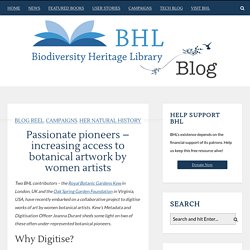
Kew’s Metadata and Digitisation Officer Joanna Durant sheds some light on two of these often under-represented botanical pioneers. Why Digitise? Historically, female botanists and botanical artists were rarely given as much credit as their male counterparts. Botanical art was often viewed as a pleasant pastime for women who had time on their hands whilst their husbands were at work, and the contribution that these women made to the advancement of scientific illustration was often undermined.
Kew holds over 200,000 prints and drawings, and this working resource is available to staff and visitors to the department, often providing a reference tool against preserved herbarium specimens. From Canada’s National Capital to “the Rock” — The Tale of a Traveling Book by Philip Henry Gosse. The Island of Newfoundland was nicknamed “The Rock” because of its rocky terrain and high cliffs. I’m Elizabeth Smith, and I work at the Canadian Museum of Nature’s Library & Archives as Acquisitions and Cataloguing Officer.
In this capacity, I have the privilege of caring for a rare book collection consisting of approximately 4,000 pre-20th century monographs, manuscripts and periodicals, including a special unpublished manuscript, Entomologia Terrae Novae by Philip Henry Gosse — which I had the privilege of hand couriering to St John’s Newfoundland for a short exhibit and panel talk at Memorial University’s QEII Library this past September. Elizabeth Smith is an acquisitions and cataloguing officer with the Canadian Museum of Nature in Ottawa. Here she holds Philip Henry Gosse’s unpublished manuscript, Entomologia Terrae Novae. (Francesa Swan/CBC). BHL at Biodiversity Next. Biodiversity_Next main conference venue, Stadsgehoorzaal, in Leiden, Netherlands.
Photo Credit: Grace Costantino. In October 2019, more than 700 people from over 75 countries gathered in Leiden, the Netherlands for Biodiversity_Next, a joint conference by GBIF, DISSCo, iDigBio, CETAF, TDWG, and LifeWatch Eric. The first conference of its kind to bring together so many major international biodiversity organizations, the conference aimed to promote innovation in biodiversity and geodiversity information management and applications; encourage collaboration across these communities to enhance data standards and management practices; and foster the development of the skill sets necessary to embark on data-intensive scientific research and solutions.
BHL colleagues from around the world traveled to Leiden for Biodiversity_Next. Eighteen BHL-affiliated representatives from our partner community, representing 13 institutions from nine countries, attended the conference. BHL Journal Articles Are Now Discoverable via Unpaywall. Earlier this week, Rod Page and I received an email from Richard Orr, the Lead Developer at Unpaywall, telling us that he had created a work-around that would finally enable the Unpaywall extension to discover content in BHL. And I (Nicole) literally spent the rest of the day jumping for joy. Let us explain: Firstly, what’s a DOI? DOIs (Digital Object Identifiers) are used throughout the scholarly research community to uniquely identify academic articles. Provenance and Library Stamps at Museums Victoria and on BHL. On the BHL blog, we often focus on the extensive biodiversity information made available through BHL and the innovative ways scientists are using the vast quantities of historical biodiversity data in BHL to conduct contemporary research.
BHL is also useful for a range of non-scientific research, however, and is used by researchers in the arts and humanities as well as the sciences. Artists draw on the illustrations for inspiration, while humanities scholars use the digitised collections for historical research. For librarians and book historians, BHL contains a wealth of provenance information, as well as the material to conduct comparative research. As a librarian in charge of a rare book collection specialising in natural history, I often use BHL to check if our copy of an item is complete, bound in the usual manner, or coloured in the same way as other copies.
Fig. 1. Live Digitisation for BHL at the Long Night of Museums in Berlin. 2019 Summer BHL Newsletter Now Available! BHL Journal Articles Are Now Discoverable via Unpaywall. Unearthed! Smithsonian Libraries' Paleo Collection. BHL at the 2019 Society for the Preservation of Natural History Collections (SPNHC) and Digital Data in Biodiversity Meetings. BHL Adds Functionality Allowing Partners to Upload Crowdsourced Transcriptions of Digitized Archival Materials. BHL Participates in the Global Names Workshop. BHL Adds New, Easier Article Download Feature. We’ve added functionality to the BHL book viewer that makes it easier to generate a PDF for an article. When you are viewing an article that has been defined in BHL, you can now quickly and easily generate a PDF of that article using our new “Download Article” option in the “Download Contents” dropdown menu. “Download Article” option in the “Download Contents” dropdown menu.
Changes Coming to the BHL Data Exports Files on 10 April 2019. Announcing Full Text Search on BHL! – Biodiversity Heritage Library. We’re thrilled to announce that full text search is now available on the Biodiversity Heritage Library! With this new functionality, search results in the library will display hits for your term in both the bibliographic information (i.e. title, author, subject, publisher, related titles and series, etc.) as well as the full text of books in BHL. Announcing the New “About BHL” Site! 2019 Spring BHL Newsletter Now Available!
A Book’s Eight Year Journey to the Biodiversity Heritage Library: Fulfilling a Researcher’s Digitization Request and Advancing Science. As an early work in the history of Linnaean taxonomy, Beredeneerde catalogus van eene, by uitstek fraaye en weergaalooze verzameling, zoo van inlandsche als uitheemsche vogelen, viervoetige en gekorvene dieren (i.e.
Vroeg’s Catalogue, 1764) by Adrian Vroeg is the source of dozens of new species of birds [1]. Published just six years after the 10th edition of Linnaeus’ Systema Naturae — considered the starting point of zoological nomenclature — the work is extremely rare, with only a handful of copies known to exist worldwide. Worlds of Wonder: Tracing Microscopy Illustrations on Zooniverse. #HerNaturalHistory: Campaign Report and Outcomes. 2019 BHL Annual Meeting at Cornell University. Biodiversity Heritage Library - Help. Color Our Collections: The Art of Intaglio Printing. Biodiversity Heritage Library - Developer Tools and API. BHL at the 2nd Global Biodiversity Informatics Conference. BHL at the Joint Society for the Preservation of Natural History Collections (SPNHC) and Biodiversity Information Standards (TDWG) Conference in Dunedin, New Zealand.
Field Note-Worthy: Thousands of Field Notes Now Available in BHL Thanks to the Field Notes Project! Report on the XIX International Botanical Congress, Shenzhen, China, July 2017. BHL Moves to HTTPS. Early Women in Science. Biodiversity Library Exhibitions. BioStor. A Report from the MBLWHOI Library: BHL Supports the Research of Recent Catherine N. Norton Fellows. Finding Refuge in the Library: How BHL Inspired the Mycological Book Club. New Designs to Help Save Biodiversity: Shop the New BHL Store Collection Today.
The Worcester Country Horticultural Society. Eye-catching photos, drawings and clippings: a few highlights from the BHL Field Notes Project. Promoting the Biodiversity Heritage Library and Scholarly Communications at the Mpala Research Centre in Kenya. iPhylo: Biodiversity Heritage Library sparklines. iPhylo: Visualising the Biodiversity Heritage Library as a Timeline. BHL and Our Users: Rod Page and BioStor. Foundations to Actions. Expanding Library Impact through Open Access Digitization. BHL Welcomes Three New Affiliates. NDSR Residents Mid-Year Update. In-copyright Titles from the 2nd quarter of 2017. 2016 BHL Annual Report Final.pdf. Cats & Women: Why the Connection? My Experience as a BHL Product Development and Marketing Intern.
BHL Welcomes Oak Spring Garden Foundation as a New Affiliate. TDWG 2017 Annual Conference: Data Integration in a Big Data Universe: Associating Occurrences with Genes, Phenotypes, and Environments. Presentation Roundup. New Medical Botany Titles in BHL Thanks to The New York Academy of Medicine. Be Like a BHL Librarian and Edit Wikipedia for #1Lib1Ref. BHL Australia - Now a Truly National Project.
Teaching with Historic Biodiversity Publications. New IMLS-Funded Project: Expanding Access to Biodiversity Literature. From BHL User to BHL Ambassador: Becca Greenstein Helps Spread the Word about BHL. Flickr Tagging Tutorial. Browse Shark Week Collection. Celebrating Mary Gunn and 100 Years of Library Excellence in South Africa. BHL Collections. The Worcester Country Horticultural Society. Biodiversity Heritage Library - About. CBHL 2017: Expanding Access visits the Twin Cities.
Report from the Digital Data in Biodiversity Research Conference, University of Michigan. New Biodiversity Heritage Library Links on EOL - Encyclopedia of Life. Expanding Access to Biodiversity Literature. BHL Highlighted As A Case Study For Sustainability. BHL Promotes Biodiversity Research and Taxonomy. The Field Book Project. New Medical Botany Titles in BHL Thanks to The New York Academy of Medicine – Biodiversity Heritage Library.
American Daffodil Society Expands Access through BHL and ‘DaffLibrary’ – Biodiversity Heritage Library. BHL through the Eyes of a Student: An Inspiring Window to Natural History – Biodiversity Heritage Library. North American Mycological Association Shares Work on Fungi. Changing Uses of Herbarium Data in an era of Global Change: An Overview Using Automated Content Analysis. We Need Books to…Identify New Species. DeepL.